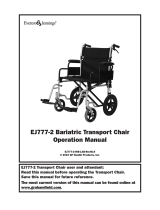
5
G
E
N
E
R
A
L
G
U
I
D
E
L
I
N
E
S
PROCEDURE 1
GENERAL GUIDELINES
SAFETY/HANDLING OF THE HTR
Safety and Handling of the HTR requires the close
attention of the HTR user as well as the assistant.
This manual points out the most common procedures
and techniques involved in the safe operation and
maintenance of the HTR. It is important to practice
and master these safe techniques until you are com-
fortable in maneuvering around the frequently encoun-
tered architectural barriers.
Use this information only as a basic guide. The tech-
niques that are discussed on the following pages have
been used successfully by many.
Individual HTR users often develop skills to deal with
daily living activities that may differ from those de-
scribed in this manual. Invacare recognizes and en-
courages each individual to try what works best for
him/her in overcoming architectural obstacles that they
may encounter, however ALL WARNINGS and CAU-
TIONS given in this manual MUST be followed. Techniques
in this manual are a starting point for the new HTR
user and assistant with safety as the most impor-
tant consideration for all.
Stability And Balance
WARNING
ALWAYS wear your seat positioning strap. Inasmuch
as the SEAT POSITIONING STRAP is an option on the
HTR (You may order with or without the seat posi-
tioning strap), Invacare strongly recommends or-
dering the seat positioning strap as an additional
safeguard for the HTR user.
5000/5500 MODELS ONLY - Anti-tippers MUST BE
attached at all times. Inasmuch as the ANTI-TIP-
PERS are an option on the HTR (You may order
with or without the anti-tippers), Invacare strongly
recommends ordering the anti-tippers as an
additional safeguard for the HTR user.
To assure stability and proper operation of your HTR,
you must at all times wear your seat positioning strap
and maintain proper balance. Your HTR has been
designed to remain upright and stable during normal
daily activities as long as you do not move beyond
the center of gravity.
GENERAL WARNINGS (CONTINUED)
WEIGHT LIMITATION
The HTR Tilt/Recline has a weight limitation of 250 lbs.
Virtually all activities which involve movement in the HTR
have an effect on the center of gravity. Invacare recom-
mends using seat/chest positioning straps for additional
safety while involved in activities that shift your weight.
DO NOT lean forward out of the HTR any further than
the length of the armrests. Make sure the casters are
pointing in the forward position whenever you lean for-
ward. This can be achieved by advancing the HTR and
then reversing it in a straight line.
The HTR Tile/Recline MUST be operated by an atten-
dant when the chair is in any tilted or reclined position.
Coping With Everyday Obstacles
Coping with the irritation of everyday obstacles can be
alleviated somewhat by learning how to manage your
HTR. Keep in mind your center of gravity to maintain
stability and balance.
A Note To HTR Assistants
When assistance to the HTR user is required, remem-
ber to use good body mechanics. Keep your back straight
and bend your knees whenever tilting the HTR or tra-
versing curbs, or other impediments.
WARNING
DO NOT attempt to lift the HTR by lifting on any
removable (detachable) parts. Lifting by means
of any removable (detachable) parts of the HTR
may result in injury to the user or damage to the
HTR.
Also, be aware of any removable (detachable) parts.
These must NEVER be used for hand-hold or lifting sup-
ports, as they may be inadvertently released, resulting in
possible injury to the user and/or assistant(s).
When learning a new assistance technique, have an
experienced assistant help you before attempting it alone.
Percentage of Weight Distribution
WARNING
DO NOT attempt to reach objects if you have to
move forward in the seat or pick them up from
the floor by reaching down between your knees.
Changing the seat depth of the chair changes
the stability of the HTR. To maintain stability, safety
limits for bending, reaching and transferring ac-
tivities MUST be re-evaluated by a qualified
healthcare professional BEFORE using the HTR.























